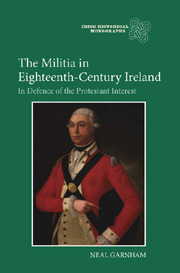Book contents
- Frontmatter
- Contents
- Preface
- Acknowledgments
- Abbreviations
- Introduction: Militia issues
- 1 To 1691: Precursors
- 2 1692–1716: Establishment
- 3 1716–59: Maintenance
- 4 1760: Action
- 5 1761–69: Reform Debated and Attempted
- 6 1769–78: Reform Achieved
- 7 1778–82: Volunteering Ascendant
- 8 1782–85: Fencible Men and the Militia Reconsidered
- 9 1785–93: Indecision and an Act
- 10 Conclusions
- Bibliography
- Index
6 - 1769–78: Reform Achieved
Published online by Cambridge University Press: 05 February 2013
- Frontmatter
- Contents
- Preface
- Acknowledgments
- Abbreviations
- Introduction: Militia issues
- 1 To 1691: Precursors
- 2 1692–1716: Establishment
- 3 1716–59: Maintenance
- 4 1760: Action
- 5 1761–69: Reform Debated and Attempted
- 6 1769–78: Reform Achieved
- 7 1778–82: Volunteering Ascendant
- 8 1782–85: Fencible Men and the Militia Reconsidered
- 9 1785–93: Indecision and an Act
- 10 Conclusions
- Bibliography
- Index
Summary
Lord Townshend emerged in the wake of the confused sessions of 1767–9 as a resident lord lieutenant. Whereas previous viceroys had stayed in the country only for as long as the meeting of parliament made it necessary, Townshend, either on his own initiative or at the behest of the London government, made the decision to become resident in Ireland for the entire duration of his tenure of office. His appetite for reforming the government of Ireland went much further than this symbolic measure, however. Frustrated by the inability and unwillingness of the undertakers to deliver the augmentation promptly, Townshend began to disassemble the political machinery of the country. By dismissing numerous officeholders and massively expanding the patronage of the Crown, Townshend and his able chief secretary, Sir George Macartney, created a ‘Castle party’ through which they themselves could wield influence in the Irish Commons without the need of intermediaries. As a result the lord lieutenancies of Townshend and his successor Lord Harcourt have been described as marking ‘the highpoint of the British government's policy of closer control’ in Ireland. With the administration exerting so much control and influence within the Irish parliament, it was no longer necessary for it to offer major concessions to the opposition in order to ensure the passing of its own measures. The former undertakers found themselves sidelined and, in a fit of righteous indignation, joined the opposition.
- Type
- Chapter
- Information
- The Militia in Eighteenth-Century IrelandIn Defence of the Protestant Interest, pp. 89 - 100Publisher: Boydell & BrewerPrint publication year: 2012



